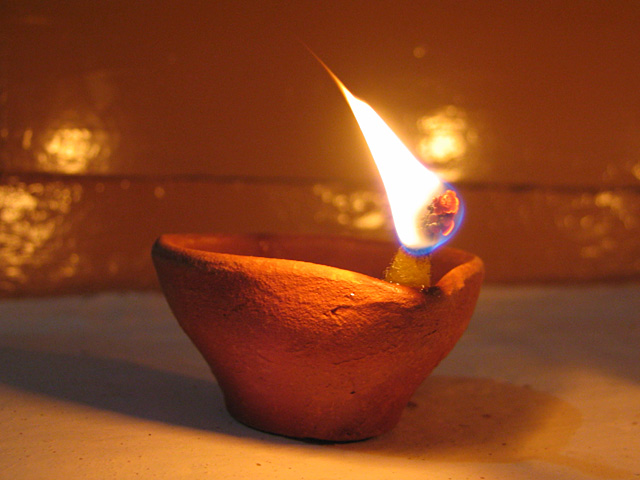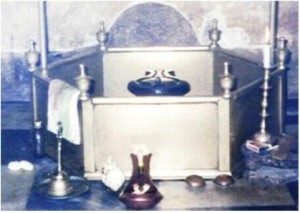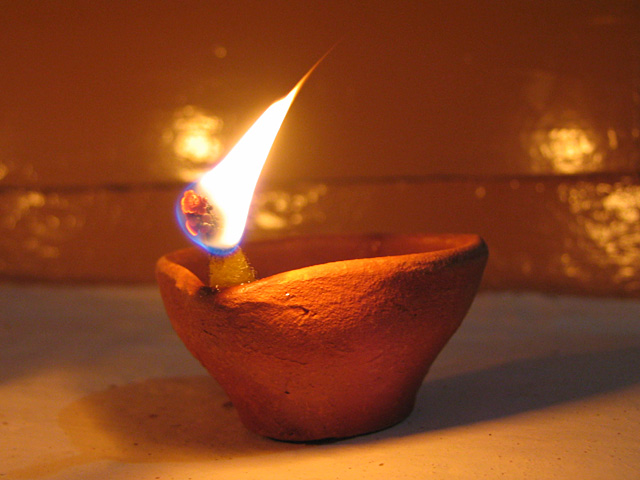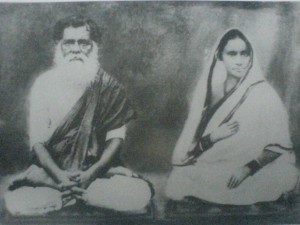In his previous life, His Holiness Mahatapasvi Shri Kumarswamiji was in Gyanganj (Jnanganj) Ashram in the Himalayas. His name was Swami Kshemananda then and his Guru was Paramhansa Swami Nemananda Ji. In Jnanganj Ashram there are two branches – Yoga and Science. Swami Kshemananda Ji was a student in Yoga branch. In this life, as Shri Kumarswamiji, he was in close and continuous contact with Gyanganj Ashram. Gyanganj Ashram has many adepts working for the benefit of mankind and the whole universe. To mention a few names of the adepts of Gyanganj Ashram – Paramhansa Maha Tapa Ji Maharaj, Paramhansa Bhrigu Rama Ji, Paramhansa Nemanand Ji, Paramhansa Abhayanand Ji, Paramhansa Jnana-nanda Ji, Paramhansa Vishuddhananda Ji. There are many Bhairavis (women adepts) too – Uma Bhairavi, Shama Bhairavi, Jnana Bhairavi etc. While Paramhansa MahaTapa Ji Maharaj is head of Jnangang Ashram, Uma Bhairavi is head of medical unit of Jnanganj Ashram.
Paramhansa Vishuddhanand Ji Gandhababa is His Holiness Shri Kumarswamiji’s Guru-bandhu (brother-disciple) from his past life. Towards the end of his this life, Shri Kumarswamiji consulted with his Gurudeva and the adepts from Gyanganj Ashram; for his Sadhana (penance and spiritual practices) in this life was not complete and asked them what should be next course of action therefore. The adepts asked Shri Kumarswamiji to build a temple with his own money and place the spiritual power which he had accumulated in his 50-years long penanace. At the mandate of the adepts from Gyanganj Ashram, Shri Kumarswamiji built Divya Devalaya, the Divine Temple in 1995 at Tapovan, Dharwad. The Divine Temple does not have any image or idol or deity. It has 7 mantras written on the wall which holds Shri Swamiji’s spiritual power. The adepts also told Shri Kumarswamiji that they would send one of their adepts (Siddha-purush) from Jnanganj to reside in the Divine Temple. Accordingly Shri Kumarswamiji’s elder Guru-bandhu, Paramhansa Shri Vishuddhanand Ji Gandhbaba has come to stay in the Divine Temple at Dharwad in his subtle body.
The Divine Temple is maintained in strict accordance with the rules laid by the adepts from Jnanganj ashram.
Bholanath in Gyanganj (Jnanganj) Ashram
Bholanath embarked on his regular training in Yoga in Gyanganj Yogashram, under the expert guidance of Shri Bhriguram Paramahansa. His sharp intellect and rigorous application enabled him to atain complete mastery over the eight stages of Yoga, one by one, in a period much shorter than other aspirants who inspite of having started earlier, had not yet attained the same proficiency.
Shri Bhriguram Paramahansa was greatly impressed by Bholanath’s intensity of purpose and dedication. In appreciation thereof, he gave away the ‘‘Harihara Banalinga” – Shivalingam which was in use in the Ashram, for testing the progress of trainees – to Bholanath as a prize.
This was a Shivalinga in Gyanganj Yogashram which was exceptionally powerful. It was used for testing the progress of trainees in Yogic Tratak. Ordinary aspirants of Yoga could not fix their gaze at it steadily for any length of time. Only Brahmacharis and Yogis fully established in Yoga technique were able to fix their gaze upon it for a while. Its colour would change after every three hours interval and its hue would thus change eight times during the twenty-four hours of day and night. Many people have witnessed the two-fold forms of the Lord viz. Hari (Vishnu) and Hara (Shiva) in it and hence this Shivalinga had been named as Harihara Banalinga. This Banalinga was greatly instrumental in Bholanath’s meteoric rise in the practice of Yoga. The residents of the Ashram took strong objection to the presentation of this Banalinga by Shri Bhriguram Paramahansa to Bholanath. They claimed that not only was it the property of the Ashram, but it was in constant use here as an instrument for testing the progress i.e., the stage of attainment of Yoga-aspirants. Hence it could not be handed over to an individual. Bhriguram Swami explained to them that he had taken the decision to present this Banalinga to Bholanath because he deserved it fully by virtue of his excellent performance and showing in Yoga-practice. It was also quite true that this Banalinga would no longer be available at Gyanganj Ashram, but it would soon be installed at a very auspicious place in Bengal. And any one of you could go there and offer prayers and concentrate on it, as distance does not present any hindrance or obstacle and is therefore of no consequence to a Yogi. Besides, its installation in Bengal would be of immense public-benefit.
Gurudeva, Shri Mahatapa Maharaj, approved the action of Shri Bhriguram and blessed Bholanath. This Banalinga could stand the gaze of Bholanath during his meditation. Ordinary Linga could not normally stand his gaze and would get shattered to pieces. After some time Bhriguram Swami directed Bholanath (Vishuddhanand) to instal this Banalinga in the village of his birth viz. Bondul, in a temple and have an Ashram built alongside. The Swami made it clear that it was to be installed in Bondul and Bondul ony. He even indicated the spot for its installation saying that on digging at the mentioned spot Trishul (Trident) would be found about two metres below the ground. The Harihara Banalinga was installed during auspicious Muhurta (moment) under the name of Bonduleshwara.
Harihar Jnanganj Banlinga (Banduleshwar) at Bandul
In this way, under the instructions of Swami Bhriguram Paramahansa, Bholanath developed into a perfect Yogi. He spared no pains to learn natural sciences under the tutelage of Swami Shyamanand Paramahansa. He learned Vayu-Vijnan (science of natural sciences), Nakshatra-Vijnan (astrology), Chandra-Vijnan (lunar science), Swara-Vijnan (science of sound vibrations), Kshana-Vijnan (science of instant of time) and Surya-Vijnan (solar science) etc. Like in Yoga, Bholanath attained great prificiency and mastery in all above sciences also.
Yogiraj Vishuddhanand Paramhansadeva was the first Yogi-Saint to introduce and propagate Surya-Vijnan, solar science, into the world for the first time. Up till then this science was confined to the precints of the ancient secrets of Yogashram at Gyanganj in the Himalayas in Tibet and was known only to the ancients. Baba stayed in Gyanganj Ashram for 12 years. Surya i.e., Sun or Savita means ‘source of creation’. According to Surya-Vijnan there are 360 rays of the sun which go to form the whole creation of the Universe. Baba converted cotton wool, flowers and leaves into stones, wood, etc. by the incidence of appropriate rays of the Sun. He demonstrated practically how minute particles of ingredients of various objects could be dispersed or assembled and destroyed or created through the proces of Surya-Vijnan. As a result of his adherence to the strict rules of the Brahmacharya period, Bholanath had freed himself from the influence of ego and had also developed the spirit of surrender to the will of the Supreme Power.
Bholanath, now Swami Vishuddhanand, had acquired many super-natural powers through the constant practice of Mantra Jap (meditation), Tapasya (penance) and Samadhi (super-consciousness). But he used to utilize these Siddhis only for the benefit of mankind. Whenever requested, he used to provide relief to all relatives or non-relatives in their bodily and mental sufferings and all kinds of troubles. Many people suffering from chronic and virulent diseases were cured just by a single benevolent gaze from him or by the exercise of his will-power.
Vishuddhanand had unlimited faith in his Guru and he accepted the command of his Guru even though it was not to his own liking. After having lived as a Sanyasi for four years, Swami Vishuddhanand did not like the idea of marriage. He, however, implicity believed in the dictum that the Guru’s commands, deeds and thoughts are always directed toward promoting the good of the disciple. Hence, when his Guru, Mahatapa Maharaj, asked him to marry, he bowed down to his command and agreed to lead the life of a householder. With all humility, he only enquired of his Guru, ”Gurudeva, I hope my marriage will not stand in the way of my progress in Tapa, i.e., practice of austerity.” The Guru replied, ”No, with my blessings the influence of your Tapa will increase day by day after marriage instead of declining” and this proved to be true. After his marriage Vishuddhanand pursued his spiritual austerities with even greater vigour and tenacity. He soon attained the stage of Tirth-Swami and during that period he acquired many additional Yogic Siddhis.
Paramhansa Ji with Mata Ji
After marriage, Vishuddhanand went to his in-laws’ place at Manteshwar. There he went to the pond for his daily bath. The pond was overladen with water weeds. While bathing, he was bitten on his chest by a snake. He immediately came out of the pond. Blood was flowing out of the bitten spot. Vishuddhanand entered the Shiva temple at the pond and told his brother-in-law to ensure that nobody entered the temple till such time as he prayed inside it, irrespective how long he took inside, so nobody disturbed him. The whole day went by, the whole night passed. Only on the second day in the morning, the door of the temple was opened from inside and he emerged. His eyes were blood-red and the whole body was wet with perspiration, but there was no visible sign of snake-bite poison, except the dent’s of snakes fangs on his chest.
The above information is taken from the book – “Yogirajadhiraj Swami VISHUDDHANAND PARAMAHANSADEVA, Life & Philosophy” by Nand Lal Gupta, an ardent disciple of Shri Babaji for the benefit of Babaji’s devotees across the world..





